CWs Remarkable Reefing System
|
|
This post was updated on .
Chris,
Thinking about your remarkable reefing system, I'm confused about the details, like the toggle and loop at the front of the boom. Paul |

|
Chris Waite |
Re: CWs Remarkable Reefing System
|
|
This post was updated on .
I just happen to have taken some more snaps of the system on Polly Wee and here they are; with tortuous explanations as ever. There are other ways, but I take in a reef in three ordered stages
By way of preparation, heave-to and release the mainsheet, which has the added advantage of bringing the tack aft and up wind, where it is easier to reach. Drop the sail into your double topping lifts, sufficiently to lurk close to the boom, (not right down as the folds make it difficult to grope around trying to perform the next bits), then - 1. Shorten the luff to the reef cringle. On a (balance) lug, this creates a problem that does not occur on any luff with attachments to the mast, the free luff below the cringle can now balloon out, as the wind blows into and past it. To prevent this I have a strop permanently rove through the cringle itself, with a stainless ring in one end and a toggle on the other. Under the forward end of the boom there is a forward facing stainless lacing hook Loop the ring over the hook and gather the redundant free luff into a rolled sort of heap, wrap the strop round the result, pulling on the toggle as necessary and run the toggle end into the hook as well - 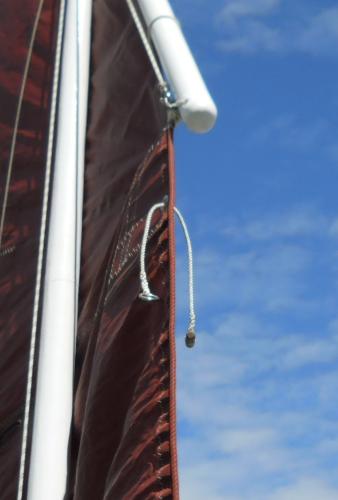  2. Bring down the leach cringle. This requires that you haul-in on the sheet until you can reach the cringle itself. To minimize the amount of string trying to get in the way anyway, I have the pennant tied loosely round the boom in a bowline, so that it is free to slide (aft) until it can pull directly under the fully extended reef. Make sure this is far enough aft not to foul the lacing on the boom. Take the pennant loosely up to and through the leach reef cringle and make it off in a parrel bead, or similar (toggle or ring again). Under full sail, this will lie up the leach, with no dangles - 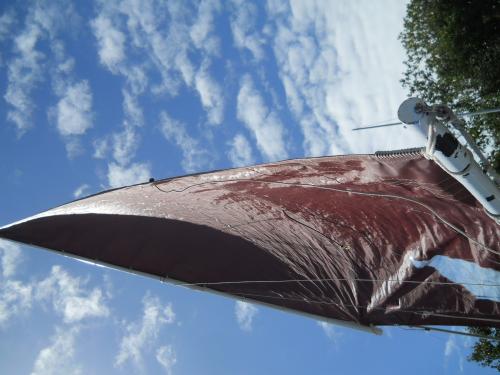 Irritatingly, advances in the cyber world mean pictures that used to be rotatable, now revert to their original orientation, regardless of subsequent instructions to stand on one side, or whatever makes sense to the human brain. I could comment again on the glorious minds that achieved such a conundrum, but I cannot expect you to cope with the profanities involved, so just turn your screen right side down to see the pennant and the little back dot up the leach, which is a small brown parrel bead. Next a rather more substantial hook facing aft and down at about 30 degrees on the other side of the boom from the bowline (making it the same side as the parrel), some four to six inches behind the fully extended reef. Also a tad less than the length of the pennant forward of that a (open-sided clam) cleat. This is from an earlier series of images - 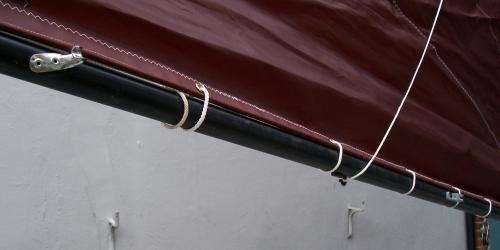 Note firstly the aft-facing black Nylon hook and that is the double topping-lift running through it; secondly the slightly grubbier loop of the bowline just aft of the whiter lacing loop. Now, where were we? Grab the parrel bead and lead the pennant round the aft facing hook, hauling taught forward, inside the topping lift and make it off in the clam cleat -  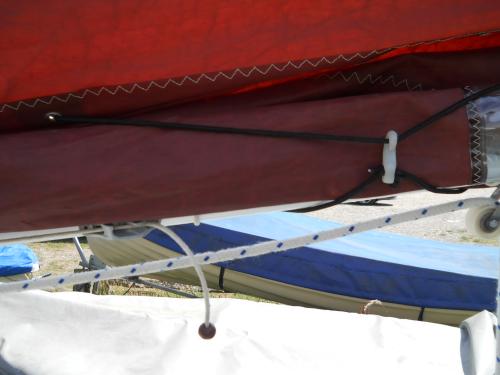 (Tip - Do NOT put any cleat under the boom, as it will try very hard to thank you, personally, every time you go about.) 3. Dowsing the bunt. The last thing to do is a luxury; the wind will try and get into the baggy centre of the reefed sail and blow it up into a floggy sort of balloon. Originally I had a white line doubled through the reef eyelets, but even that is more complicated than it needs to be for a sail of this size and now I have just the one black bungee line with a hook running on one side - 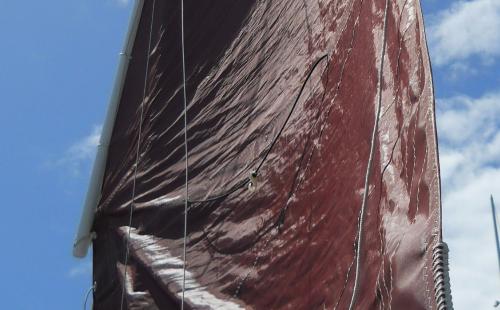  Same picture again, but this time it is showing the black bungee hooked to itself under the boom cuddling the bunt quite snugly, don't you think? I note that you have two reefs Grum. Another trick to reduce string, is to make your second pennant off at the first reef leach cringle, rather than the boom bowline, so that it stays lying up the leach, even when the first is tied in. That is rather than having any spare dangling below the boom with one eye on your neck. You will need a second set of aft hook and clam cleat, but then you'll need a second set anyway. And lastly, I've just noticed a little something from my ramblings above.... If I 'save' a 'cropped' picture then that overrides the orientation issues - 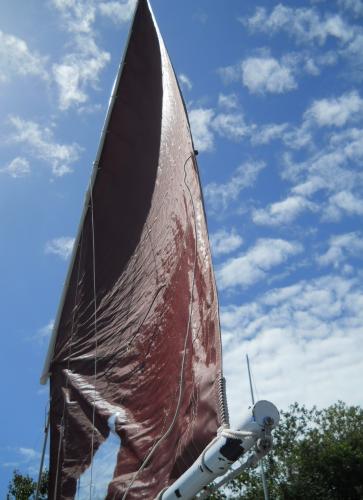 See; you didn't feel a thing did you? And me a pre-electrolyte And all that! CW |

|
Chris Waite |
Re: CWs Remarkable Reefing System
|
|
This post was updated on .
In reply to this post by Paul H (admin)
Here you go Paulie
This is the hook under the forward end of the boom - 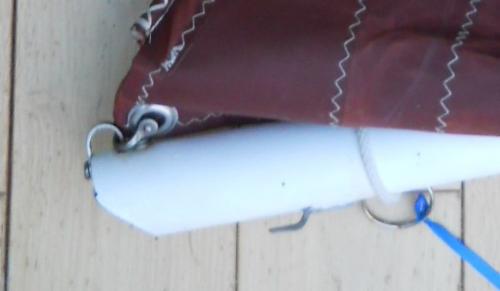 It's really quite small, as it is only a stainless lacing hook - https://www.marinesuppliesdirect.co.uk/stainless-steel-inline-lacing-hooks-pack-10-4188-p.asp Can I point out that the luff is free-standing on a lug, thus can blow out into an informal wind scoop unless restrained when reefed, so it needs a strop wrapped round it to keep it snugged down. On your gunter sail, you should not need this as you have lacing eyes in the luff to hold it to the mast. The simplest way to deal with your sort of luff is to have a sliding roband, (a toggled strop covered in nylon tube) on each eye - 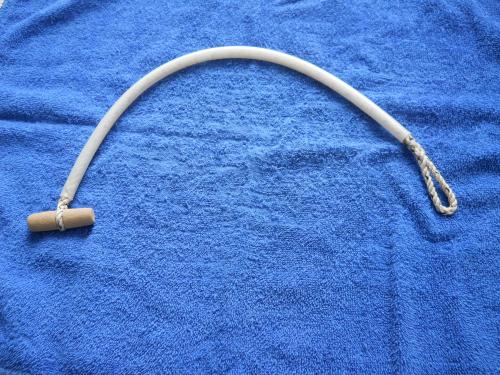 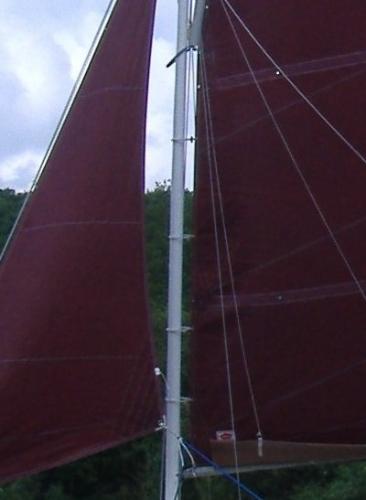 I have four on Tit Willow's gaff main above. No matter how loose or taught and long or short, the luff is held at the correct distance from the mast. The reef cringle can then just be held at the gooseneck with a simple hook. I think we made one up for you last summer at Cobnor - yes? The larger hook on the side of the boom aft needs to be more substantial as the stress on it is not taken round the boom itself. I found the one on Polly Wee's boom in a chandlers somewhere. The sail bundle was hanging up in the garage roof; I've just got it out and looked at the hook, which has Ronstan RF88 stamped into it; so I popped it into my browser.... Low and behold, Ronstan have an immense amount of trouble admitting to its existence, though they think it might be a Thumb cleat The convenience of modern electronics Continues to astound me Chris |
|
|
This post was updated on .
Jolly good, I've ordered an RF88 and a pack of lacing hooks.
Ebay sells wooden toggles, last seen in the 60s I think! I ordered two types, to experiment a bit. These cleats look useful, for 3-6mm rope. The line is less likely to get pulled down: 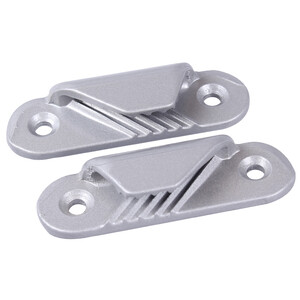 https://www.force4.co.uk/item/Clamcleat/Fine-Line-Cleats/IA8 Paul |
|
|
This post was updated on .
Jolly Good Paulie
What are you going to use the lacing hooks for; don't tell me.... Lacing? Yes, but what? The 'sidewinder' Clamcleats are good, but again what do you mean by being "less likely to get pulled down"? Last question - where did you order the RF88's from? Chris |
|
|
This post was updated on .
All very interesting I have no doubt, but would you like to continue this over on your own thread.
Forum Decorum chaps, Forum Decorum. Paulie, you should know better. Regards The Topic Police. Sent from my Xperia by Sony smartphone |
|
|
This post was updated on .
Well said
Richard |
|
|
In reply to this post by Chris Waite
I was thinking the lacing hooks could wrap up reefing lines, akin to vacuum cleaner cables. If not, stainless hooks are useful in MilliBee's cabin, our garden for training fruit bushes or my shed.
The RF88 thumb cleat was ordered from Coast Water Sports. -Paul |
«
Return to General Discussion
|
1 view|%1 views
| Free forum by Nabble | Edit this page |
